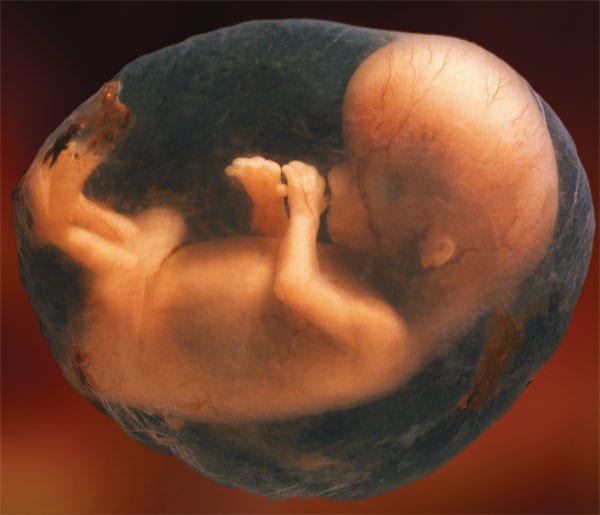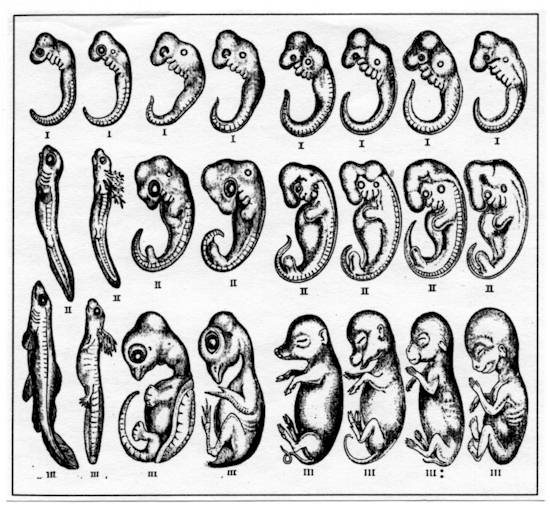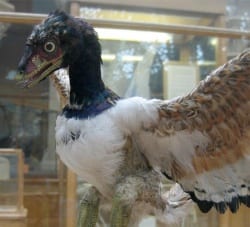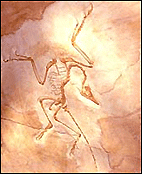Fossils of deceased creatures are not evidence of evolution. It is only the evolutionists and their artists who concoct the story. There have been many hoaxes in the name of evolution; some are mentioned below:
- Feathered dinosaur(Archaeoraptor liaoningensis): National Geographic[1] sensationalised the find of a transitional species between dinosaurs and birds complete with an illustration. It turned out to be a hoax.
- Piltdown man (Eoanthropus dawsoni): In 1912 a fossil of a human-like skull was discovered at Piltdown in England. It was hailed as the ‘missing link’ that showed humans had evolved from apes. Forty one years later in 1953, Dr Kenneth Oakley exposed it to be a fraudulent composite comprising a human skull and the jaw of an orangutan.
- Homo pongoides: The complete body of an ‘ape man’ toured the show circuit in the US during the late sixties. It was taken to be genuine and written about as such.[2] It was later shown to be a hoax.
- The horse series: Often cited as ‘proof of evolution,’ the horse series starts with the tiny four-toed Hyracotherium, sometimes called Eohippus, and moves by way of a smooth progression to the large single-toed horse of today. It looked good, but further investigation has shown it to be merely a construction to accommodate Darwinism.[3]
- Haeckel’s stages of human embryos: Ernst Haeckel promoted Darwin’s theory in Germany from 1866 by a series of sketches showing how a human embryo goes through various animal stages in the womb as it develops into a human being, such as fish gills and a monkey’s tail. Haeckel’s drawings were declared fraudulent by Professor His in 1874 and Haeckel confessed to their fabrication in a letter to Münchener Allgemeine Zeitung, January 9, 1909. Unfortunately, his drawings continue to be shown in textbooks even today and are used as an argument in support of abortion.

 Right: Haeckel’s drawings of 1874 depicting similarities of embryos of different species which he had published in Anthropogenie, in Germany in 1874. Far right: Human embryo at about 12 weeks and approximately 60 mm (2.25 inches) long.
Right: Haeckel’s drawings of 1874 depicting similarities of embryos of different species which he had published in Anthropogenie, in Germany in 1874. Far right: Human embryo at about 12 weeks and approximately 60 mm (2.25 inches) long.
When Darwin put forward his theory, he expected that paleontologists would find millions of intermediate species. In fact he wrote:
Geology assuredly does not reveal any such finely graduated organic chain; and this, perhaps, is the most obvious and gravest objection which can be urged against my theory. The explanation lies, I believe, in the extreme imperfection of the geological record.[4]

 Over 150 years later there are only a handful of hotly disputed candidates, of which Archaeopteryx is the best example. It is claimed to be an intermediate between a reptile and a bird because it has some skeletal characteristics similar to a small dinosaur and it had teeth as well. However, many extinct birds had teeth (above left the fossil and above right the model). There is no doubt that it is a bird; for one thing, it was fully feathered and had a wishbone for the attachment of muscles for the downward stroke of its wings. Its bones were hollow, which enables all birds to fly. In fact, Dr Alan Feduccia, professor and former Head of Biology at the University of North Carolina and an evolutionist himself, stated:
Over 150 years later there are only a handful of hotly disputed candidates, of which Archaeopteryx is the best example. It is claimed to be an intermediate between a reptile and a bird because it has some skeletal characteristics similar to a small dinosaur and it had teeth as well. However, many extinct birds had teeth (above left the fossil and above right the model). There is no doubt that it is a bird; for one thing, it was fully feathered and had a wishbone for the attachment of muscles for the downward stroke of its wings. Its bones were hollow, which enables all birds to fly. In fact, Dr Alan Feduccia, professor and former Head of Biology at the University of North Carolina and an evolutionist himself, stated:
Paleontologists have tried to turn Archaeopteryx into an earth-bound dinosaur. But it’s not. It is a bird, a perching bird. And no amount of paleobabble is going to change that.[5]
Dr Colin Patterson makes the following point in response to a question regarding the lack of transitional species in his book, Evolution:[6]
I wrote the text of my book four years ago. If I were to write it now, I think the book would be rather different. Gradualism is a concept I believe in, not just because of Darwin’s authority, but because my understanding of genetics seems to demand it. Yet Gould and the American Museum people are hard to contradict when they say there are no transitional fossils. As a paleontologist myself, I am much occupied with the philosophical problems of identifying ancestral forms in the fossil record. You say that I should at least show a photo of the fossil from which each type of organism was derived. I will lay it on the line; there is not one such fossil for which one could make a watertight argument.[7]
The power of this statement is compounded by the fact that at the time Dr Patterson was in charge of possibly the largest collection of fossils in the world.
The renowned evolutionist Stephen Jay Gould wrote:
The absence of fossil evidence for intermediary stages between major transitions in organic design, indeed our inability, even in our imagination, to construct functional intermediates in many cases, has been a persistent and nagging problem for gradualistic accounts of evolution.[8]
Gould even said in another place:
The extreme rarity of transitional forms in the fossil record persists as the trade secret of paleontology. The evolutionary trees that adorn our textbooks have data only at the tips and nodes of their branches … in any local area, a species does not arise gradually by the gradual transformation of its ancestors; it appears all at once and ‘fully formed.’[9]
Forty years of research led Professor N Heribert Hilsson of Lund University, Sweden, to write:
It is not even possible to make a caricature of evolution out of palaeobiological facts. The fossil material is now so complete that the lack of transitional species cannot be explained by the scarcity of the material. The deficiencies are real; they will never be filled.[10]
[1] National Geographic, 1999, 196 (5), pages 98–107.
[2] Natural Sciences of Belgium, 45 (4), February 10, 1969.
[3] J. Safarti, Creation, 1999, 21 (3), pages 28–31.
[4] Darwin, C. (1859) The Origin of Species (Reprint of the first edition) Avenel Books, Crown Publishers, New York, 1979, page 292.
[5] V. Morell, Archaeopteryx: Early Bird Catches a Can of Worms, Science, February 1993, 259 (5096), pages 764-5.
[6] C. Patterson, Evolution, Routledge and Kegan Paul, 1978.
[7] Personal letter written 10 April 1979, from Dr. Colin Patterson, Senior Palaeontologist at the British Museum of Natural History in London, to Luther D. Sunderland; as quoted in Darwin’s Enigma by Luther D. Sunderland (Master Books, San Diego, USA, 1984, page 89.
[8] S. J. Gould, Evolution Now: A Century After Darwin, ed. John Maynard Smith, Macmillan, 1982, page 140.
[9] S. J. Gould, Evolution’s Erratic Pace, Natural History, 86 (5):14, May 1977.
[10] Cited by Scott M. Huse, The Collapse of Evolution, Baker Books, 1983, page 58.


2 Comments. Leave new
Thank you for all the work that has gone into this website and blogs. We need to witness the truth.
Many blessings, from Dawn.
Further to my earlier comments I am coming to the conclusion that Bible is the ONE & ONLY TRUE source we need in this life
Thank you for your studies and the evidence we all thirst for ! Keep up God’s good work.